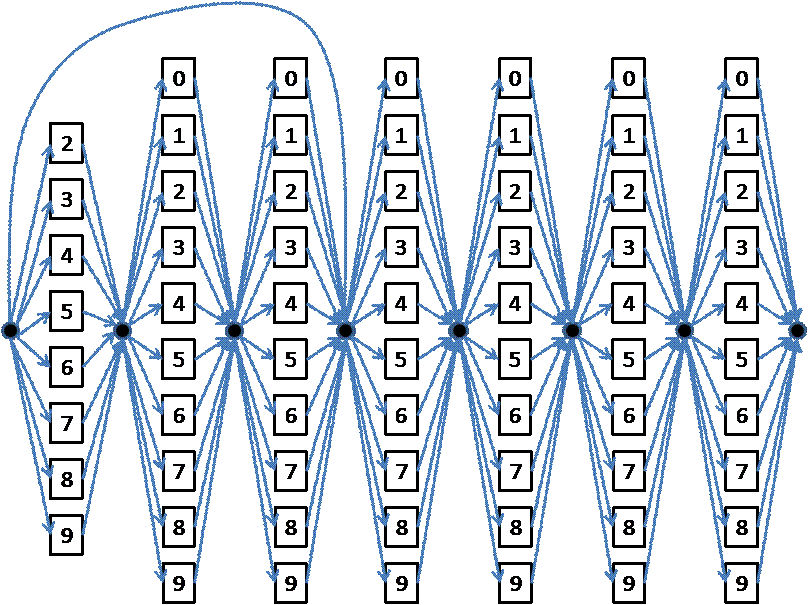
In this assignment we will write a continuous speech recognition system! Amazing as it may seem, we are ready to do this.
Problem 1: Build a continuous-speech recognition system that can recognize telephone numbers. To do so, connect the digit models you have learned via segmental K-means into the following larger HMM. In the figure each rectangular box enclosing a digit represents the HMM for the digit. Each black dot represents a non-emitting state.

Note that the above figure allows the speaker to say telephone digits numbers either as a 10-digit number or a 7-digit number. Furthermore, we are taking advantage of the fact that the first digit in a telephone number is never 0 or 1.
The grammar for the above problem, expressed in Augmented Backus-Naur format would be as follows:
telephone-number = [area-code] number area-code = first-digit digit digit number = digit digit digit digit digit digit digit first-digit = "2" / "3" / "4" / "5" / "6" / "7" / "8" / "9" digit = "0" / "1" / "2" / "3" / "4" / "5" / "6" / "7" / "8" / "9"
The above specification states that a telphone number is a combination of an optional area code and a main number, where the area code is a 3 digit number, where the first digit can be one or 2,3,4,5,6,7,8 or 9, where as the main number is a 7-digit number.
You may find it useful to read in the specification of the word graph (in the figure above) externally. External specifications are often in BNF/ABNF forms such as the one above. However, a simpler format is a finite state graph which explicitly characterizes the graph above, e.g. as
N_States: 8 Start_State: 0 Terminal_States: 7 Edge 0 1 "2" Edge 0 1 "3" Edge 0 1 "4" ... Edge 1 2 "0" Edge 1 2 "1" Edge 1 2 "2" ... Edge 0 3 Edge 2 3 "0" Edge 2 3 "1" Edge 2 3 "2" ..
Note that the digits are associated with edges in the graph. Also note the "null" edge from state 0 to state 3 that permits the speaker to skip the area code. In translating this format to a graph, each node becomes a non-emitting HMM state. Each edge in the graph becomes the HMM for a digit.
You can allow for optional pauses at specific locations (e.g. after the 3rd digit and/or the 6th digit) by having simple silence loops such as
Edge 3 3 "silence" Edge 6 6 "silence"
You will require a specially trained model for "silence" (trained from recordings of silence, possibly) for this model.
Record 25 telephone numbers randomly chosen from a telephone directory and report recognition accuracy. Accuracy is reported in terms of:
Do the above with and without pruning and report speed.
Problem 2: Do the above using a backpointer table. Report accuracies as described above.
Problem 3: Build a system to recognize unrestricted digit strings. For this we will use the following graph

In this case it is useful to assign an "insertion penalty" to the loopback to ensure that large numbers of digits are not hypothesized randomly. Determine the optimal insertion penalty empirically (by evaluating recognition error as given below) and report both the optimal insertion penalty and the recognition preformance as required below.
Record the following 10 digit strings in your voice and evaluate accuracy on them. Accuracy is to be measured in terms of:
Test data to record:
A toy example of how to form a graph. Consider a simple recognizer which recognizes arbitrary sequences of the digits "0" and "1" only. The finite state graph for it can be represented in text form as:
N_States: 2 Start_State: 0 Terminal_States: 1 Edge 0 1 "0" Edge 0 1 "1" Edge 1 0
As mentioned earlier, it is typically convenient to represent the grammar as a graph specified in the above format.
Assume we have HMMs for "0" and "1". The combined HMM can be formed as
ngrammarhmmstate = READ(N_states);
startstate = READ(Start_state);
finalstate = READ(Terminal_state);
while ([edge_source_state, edge_end_state, edge_id] = READ(Edge)) do
if (edge_id) then
[n_edgestate, edge_tmat, edge_state_meanvar] = read_hmm(edge_id);
for i = 1:n_edgestate
transition_prob [edge_source_state, ngrammhmmstate+i] = PI_edge_model(i)
end
for i = 1:n_edgestate
transition_prob [ngrammhmmstate+i,edge_end_state] = tmat_edge_model(i,edge_absobing_state)
end
for i = 1:n_edgestate
grammar_state_meanvar[ngrammarhmmstate+i] = edge_state_meanvar[i]
end
ngrammarhmmstate += n_edgestate - 1;
else
transition_prob [edge_source_state,edge_end_state] = insertion_penalty
endif
done
Note that all we are doing here is literally "inserting" the HMM for the digit in the place of the edge it is associated with. We introduce transitions from the source state of the edge to the entry state(s) of the HMM. We "merge" the final absorbing state with the destination state of the HMM.
This is no longer a true HMM -- the probabilities at some states no longer sum to 1.0. If the finite state grammar had probabilities associated with them (e.g. "Edge 0 1 AND 0.4" states that the word AND occurs on the edge between nodes 0 and 1, with a probability of 0.4) these can be included by associating the probability with entry transitions into the HMM (transition_prob [edge_source_state, ngrammhmmstate+i] = PI_edge_model(i)*PROB)
Due on Mon 1 Apr 2013